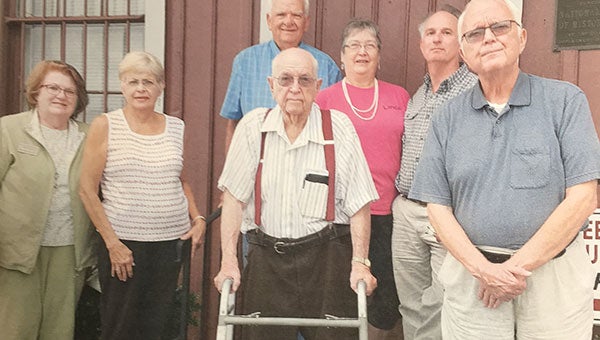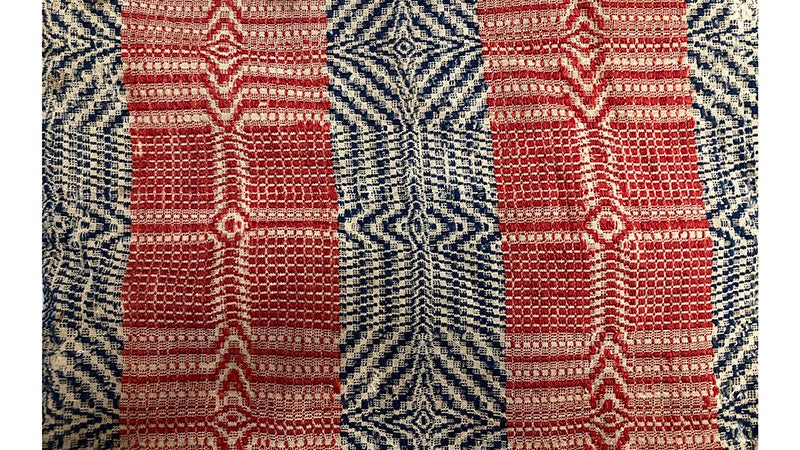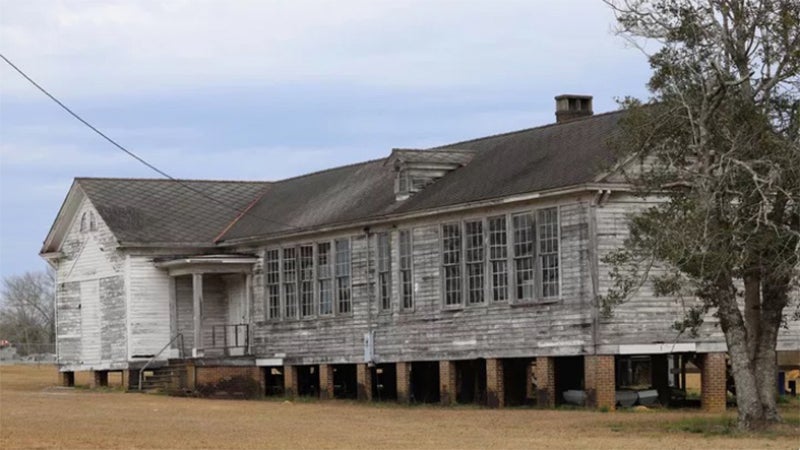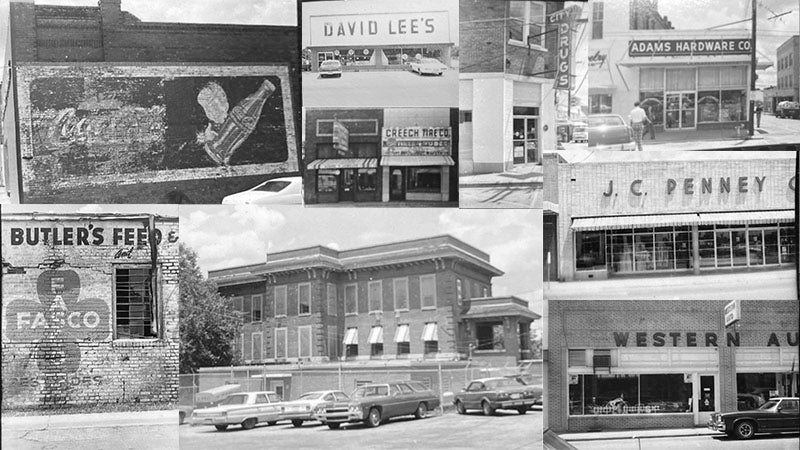Remember when: He was a pillar of the community
Published 1:09 pm Saturday, December 15, 2018

- Waits, center, is shown with (from left) Sue Bass Wilson, Nancy Robbins, Wiley Ward, Linda Henderson, David Wyatt and George Proctor.
Yes, I suppose the first time my girlfriends and I ever remember Sidney Waits was when we were about 10 years old or so – out on the sidewalk in front of his mother’s house where we were roller skating. “Mrs. Nannie Belle” was my family’s next door neighbor there on the Lorraine curve on East Three Notch Street. Tuscaloosa Concrete Company 1914 is embossed in the sidewalk where we skated across those letters back and forth umpteen dozen times! (The only stamped portion on sidewalks today marking the company who paved Andalusia sidewalks in the early 1920s is in front of the First Presbyterian Church. This is because most of the sidewalks have been replaced through the years.)
Sidney and his family along with the Byron Hairs and the Bill Rues would often pull up in the driveway and visit with the family matriarch and sit on the porch in good weather to visit. Marge Russell, Betty Radcliff, and I, all neighbors, would play with her grandchildren our age, Mary Evelyn Waits, Nancy Hair, and Tom Rue – usually in the back yard around the sundial in the flower garden. So the day that is etched in my mind is the day that Mr. Sidney Waits came out in the yard to talk to us. He did some kind of trick with his thumb where his thumb would disappear as we would holler and giggle! Back then, as a hobby he entertained children at birthday parties as a magician with magic tricks.
About that time in the 1950s, Sidney was the Andalusia Santa Claus each year. His daughter Mary Evelyn told me this story to share: “Daddy played Santa Claus for Andalusia for a number of years. He was meticulous about his Santa suit. His outfits, suit and beard, actually got better with each passing year. Mom would always help him get dressed, and she would “farm” me and my brother George out of the house to go play at our cousins’ houses just to keep us at bay. Each December, Daddy would meet former World War I Navy pilot and local friend Jimmy Utsey at the airport at Sanford. Jimmy and Santa would fly in circles around South Alabama and then land at the airport at a given time when the crowd would gather to welcome Santa from the North Pole. Children would be there to meet Santa where he would give out candy then ride in a fire truck into town. Santa would walk around the square and go from store to store greeting the customers and children. He would often end up at the J. C. Penney’s store where pictures were taken with children sitting on Santa’s lap. George and I would sit on Santa’s lap but Santa always had a plastic mask on. We just never thought anything about it! Once when I was on Sanford Road at my cousin Nancy Hair’s house, we were playing out in the yard when we saw Santa Claus ride by driving my daddy’s car! That thought didn’t stay with us long, because we always believed in the real Santa Claus!”
More than likely Jesus needed a Santa Claus character and maybe even a magician up there behind the pearly gates on December 11, 2018 to entertain the heavenly host of children, because he gave George Sidney Waits, Jr., his ‘angel wings’ on this date.
Many tributes have been paid this town historian with sobriquets including “Mr. Andalusia history,” “Prince of a man,” “Southern gentleman,” “Pillar of the community,” “The great G. S.,” “Influential community leader,” “Great patriot.” Someone on social media stated, “I was never around him that I didn’t walk away feeling better!”
Don’t get me wrong – Sidney Waits would be on my case if something went wrong to displease him at the museum! It was up and down!
In his own words Waits wrote in his book, “From the Halls of Montezuma,” “I have always been intrigued by the early history of Andalusia and Covington County. With two costly courthouse fires in our history where all records were lost, it has been a challenge to find new facts about those early years.”
Waits remembered, “My first real effort to unravel some of the mysteries of our past came when I was a sophomore at the Andalusia High School. Miss Grace Huff was my teacher, and she inspired us to write about our local history. I recall a personal interview with Judge R. H. Jones, our foremost historian of that era. He shared many facts of local history with me. Many of his personal early photographs and historical facts went into the publication of Gus and Ruby Bryan’s ‘History of Covington County.’ We are indebted to Judge Jones. Had it not been for his interest, many of the ‘footprints’ of our foundation years would have been lost in the sands of time.”
Over the years when time permitted, Waits would enjoy visiting the State Archives and History building in Montgomery where he would find pleasure in digging through old records in an effort to uncover new facts. Following his retirement in 1987, he began working as a volunteer at the Three Notch Museum which opened to the public in May 1988 after the old Central of Georgia train depot was restored and converted to a local history museum by the Covington Historical Society along with many civic clubs and individual citizens.
Not only did Waits establish a method for the accession of artifacts, he also set up numerous displays; he wrote letters and finally managed to bring the railroad caboose that proudly stands on the tracks which brought the first train into Andalusia in 1899; he was able to save and bring several box cars and another caboose to the historic district; he arranged for the Clark family log cabin and a corn crib to be moved from out in the country as well as the H. B. Little Country Store and the River Falls Post Office; he set up a boxcar for the Mark Gibson model train exhibit to be housed.
The filing cabinets are full of a collection of old postcards and photographs which he solicited for donations from older citizens and other various sources. In gathering together a number of retired ladies that assisted him at the museum, he was known to say, “Now you all come and help me from about nine o’clock until noon, and be sure to bring some refreshments, because we will take a little break about ten thirty!” He would have them cleaning, labeling, boxing, organizing, sweeping, and welcoming visitors. His leadership was quite evident. Of course, wife Polly was working right in there with him and the Museum Committee keeping him on an even keel, shall I say?
If you are ever wondering who created the round brown “Three Notch Trail” signs made that are currently located on East and South Three Notch Streets, it was Sidney Waits. He recently asked me if all of the signs that were temporarily taken down for the construction of S3N were back up yet. I said, “I will make sure they are back in place, Sidney.”
The Devereaux Hill sign that stands near the top of the prominent hillside on River Falls Street – Sidney Waits was responsible for that, too, since he did much research on John Devereaux, an early settler of the little village on the Conecuh River, Montezuma, the first settlement in the area and first county seat. John W. Devereaux sponsored the enabling act that created Covington County. He was the first postmaster (1826) and county judge for ten years which all explains why Devereaux is considered to be the “father or founder of the county.” He made sure that history was preserved and publicized.
Today not many citizens recall that settlers moved up Devereaux Hill (pronounced “Debro” with a mouth full of snuff, that is) from Montezuma to higher ground to a new site called Andalusia when the post office was moved on July 18, 1844. A chapter in the Waits’ book, “How Andalusia Got Its Name,” is worth reading. I believe that by now Sidney Waits has had a discussion up there with some of the late pioneers or the Spaniards of West Florida who came in contact with the Conecuh River rafters of timber in the Pensacola saloons or inns who suggested that the name for the new town be called ‘Andalusia’ in honor of the beauty and charm of the southern section of Spain. I can assure you that he now has the answer as to how Andalusia really got its name!
“Even today,” Waits said, “there is a friendly attitude and romantic atmosphere in our town of Old Spain with Spanish architecture in some of the homes (Scherf’s ‘Springdale’ and the Moates home on Prestwood Bridge Road) and school (Church Street School) and even a Spanish-like plaza (Court Square), an influence that has spilled over into our community life today.”
Waits’ pride and joy was discovering the history that surrounded the Horse Shoe Lumber Company in River Falls and meeting the son of founder E. L. More, Mr. Livingfield More of Nashville. A special ceremony of dedication was arranged in River Falls at the site of the bridge on the Conecuh River naming it the E. L. More Bridge designated by the State of Alabama legislature all at the request of Waits in honor of More.
The Horse Shoe Lumber Company was a sizeable timber operation in the county in the early 1900s whose manufacturing of cross ties provided the foundation of the railroad tracks that brought the new form of transportation, the trains. The Flood of 1929 ended that enterprise, but so much had been accomplished. The River Falls Power Company brought 24 hour a day permanent power to the area which resulted in growth and prosperity into the 1900s. A phone call with Mr. More of Nashville was among the last conversations Waits had from his “deathbed.” As I stood by his bedside, that was his own description of his present condition which I overheard him say to More, he expressed appreciation for their friendship and for the knowledge of the county history he had helped impart as well as his support for the museum.
Waits was a story teller like none other. His books and booklets are housed in the genealogy room at the public library, and some are for sale in the gift shop at the Three Notch Museum. Many stories from old Andalusia contained in those pages are priceless. After all, he was born in 1923, and his memory was golden!
Baptized in the old First Baptist Church downtown on September 1, 1939, he remembered church stories like the wedding there when lyric soprano Mrs. Miller sang. Back in those days before florists were in town, families and friends would help decorate the church for the weddings with greenery from their yards. “When Mrs. Miller sang one of her high notes in ‘Whither Thou Goest,’ ‘…your people shall be my people….’ The notes went up the scale higher and higher until…the frogs croaked,” Waits remembered.
He also told the historical society in one of the many programs he presented about the big summer revival at the church when all of the windows were open. Those were the days before air conditioning. A circus was in town, and the animals were being watered down on Church Street in the creek where the Robinson Memorial Park is now located. He recalled, “A monkey got loose from the circus and came up on the square making his way to the church behind the courthouse to the singing of ‘I’ll Fly Away’ or one of those gospel songs. The monkey jumped in the window and ran up and down the aisles! That revival got real lively!”
Every time I visited with my dear friend and mentor in the nursing home, as declining in health as he was, he would tell me how much our friendship and long-time association had meant to him with words of encouragement to continue preserving local history. Then he would always inquire about the museum and the society which was of great interest to him. I mentioned a thing or two and then said, “We are having our end of the year covered dish supper meeting next week.” He replied, “I’ll be there!” And I know that George Sidney Waits, Jr. always will be there.
Sue Bass Wilson, AHS Class of 1965, is a local real estate broker and long-time member of the Covington Historical Society. She can be reached at suebwilson47@gmail.com.





